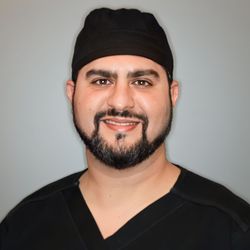The American Dental Association (ADA) recommends that all adults receive regular dental checkups, which often include dental X-rays as part of their annual exam. There are several important reasons why dental X-rays are so important when it comes to your oral health and future care. If you are considering getting dental implants, have gum disease, or are thinking about a smile makeover, it’s likely that your dentist will need to take dental X-rays of your teeth in order to properly diagnose and treat the underlying issues. Different types of imaging how often you get X-rays can help keep your smile healthy in the years ahead.
Types of Dental X-rays Dentists Use
There are several different types of dental X-rays, and each is used for a specific reason. Some show certain individual teeth, while others show several at one time. Smaller films tend to be best for assessing localized problems at certain areas of your mouth, while larger images are best for full mouth comprehensive exams and treatment planning.
The most common types of dental X-rays include:
Periapical: These X-rays of teeth show both the visible crown above the gums, as well as the entire length of the tooth roots and bone below your gum tissues. Periapical films are usually only taken on one tooth at a time, or on a couple of teeth right next to each other. They are often used for identifying the source of pain, planning root canal treatment, screening for abscesses and root fractures, or other localized concerns. If you break a tooth or need an emergency exam, for instance, your dentist will take a periapical X-ray of that tooth to determine the extent of the damage.
Bitewings: Bitewing X-rays are the films that most people are used to having taken at their regular dental checkup appointments. Bitewings show us the spaces immediately between teeth, to screen for cavities where the teeth touch side-by-side. They also allow us to look at the upper portion of the bone in those areas, to catch early signs of bone loss in people with otherwise healthy mouths. Dentists take bitewings of back teeth, but not usually front teeth.
Occlusal Films: These X-rays are slightly larger than periapical or bitewing X-rays. They are typically used to evaluate the eruption and development of upper front and lower front teeth in young children. They may be taken at the child’s first dental appointment if the child is cooperative. Especially if they are missing teeth, experiencing delayed eruption patterns, suffered a dental injury, or there are concerns related to decay and development. An occlusal film usually shows all four top or bottom front teeth at one time.
Panoramic: If you need a full mouth X-ray of all of your teeth, jawbone, and TMJ (jaw joints), a panoramic is usually what’s taken. They’re also frequently referred to as “panos”. Most new patient appointments will include a panoramic X-ray to establish a baseline reading of your oral health for that dental provider. Panoramics are also necessary when planning orthodontic therapy, dental implant placement, or wisdom tooth removal surgery. Depending on the individual and their oral anatomy, a panoramic film is usually taken once every 3 to 5 years as needed.
FMX/Full Mouth Series: Full mouth X-rays like an “FMX” consist of a combination of bitewing and periapical dental X-rays. Like panoramic films, an FMX is usually taken at your new patient appointment to establish a baseline reading of your oral health, including bone levels and root anatomy. Unlike a panoramic film, FMX X-rays do not show your TMJ joint.
3D/CT/CBCT: These three-dimensional images take panoramic films and put them on steroids. They allow dentists and dental specialists to see your full oral anatomy from every angle. You could think of them as a digital model of your mouth without taking gooey dental impressions. Except CT scans also show all of the bone anatomy throughout your jaws, TMJ, and even the soft tissues that make up your airway. They’re frequently used for virtual dental implant placement, wisdom teeth extractions, oral surgery, and even screening for sleep-disordered breathing conditions.
How Often Should I Get Dental X-rays Taken?
The frequency of your dental X-rays will depend on factors like your past oral history, current dental risks, age, and type of treatment you need. Most people get bitewing X-rays once a year at one of their regular checkups. But if you have an especially high cavity risk, you may need them taken every six months. Your dentist will help you determine how frequently they need to be taken as we can compare them from a visit to visit to monitor changes in your oral anatomy.
FMX or panoramic films are usually taken at baseline new patient appointments and every 3 to 5 years thereafter. You may need a new one taken if you are seeing a specialist, such as an implant dentist, endodontist, oral surgeon, orthodontist, or periodontist.
Occlusal films are usually only taken once or twice on small children as needed. Usually, as children become older and are able to sit through their appointment, they will graduate to having bitewing X-rays taken.
Periapical dental X-rays can be taken whenever necessary. Such as during root canal therapy, at emergency appointments, or if you are experiencing a toothache. Since they only show one tooth at a time, dentists use them more frequently during routine treatments or procedures on specific problems. However, they do not replace the need for bitewings or vice versa.
3D imaging like CBCT scans can replace panoramic films or are taken by a specialist during your consultation. Depending on what technology the office is equipped with, some patients may have access to these images while others do not. Specialized practices such as dental implant offices and dental surgeons frequently rely on 3D imaging to provide comprehensive services related to full mouth reconstruction, implant therapy, or oral surgery.
What Can a Dentist See On My Dental X-rays?
Your dentist uses X-rays for high-level diagnostic purposes. By looking at X-ray images, a dentist or dental specialist can see if there are any number of issues that otherwise aren’t visible during your clinical exam. Such as:
Cavities between teeth: One of the most common places to get cavities in between your back teeth. Taking bitewings at intermittent times will help your dentist to routinely screen for at-risk places so that cavities can be treated as early as possible. The more quickly a cavity is treated, the smaller your dental filling will be.
Abscessed teeth: Dental abscesses create small cysts filled with infection at the tip of tooth roots. These infections can drain out the end of your root tip creating small pimples or fistulas on the gums next to it. If your tooth is sensitive to hot temperatures, pressure, or pain comes and goes, you might have an abscessed dental nerve. X-rays may complement other types of testing during your diagnostic exam.
Broken tooth roots: Root fractures can be difficult to diagnose, aside from pain whenever you bite or chew on that tooth. When your dentist is evaluating the tooth and determining the best treatment, they will need an X-ray of the entire root to check for visible physical damage. Especially after some type of an injury, like a car accident or getting hit in the mouth during a ball game.
Cysts or tumors in the bone: It’s not uncommon for people to have bone cysts or tumors inside of their mouths that don’t otherwise cause any symptoms. Sometimes these cysts are associated with tooth development or some type of a bone infection. Other times they are completely benign. But occasionally such abnormal growths or abnormalities may require surgery or a referral to a specialist for a biopsy. Panoramic X-rays or 3D scans are usually best for identifying and screening for these types of bone discrepancies.
Bone loss: X-rays of the back teeth show us a quick view of where the bone levels relate to the roots of your teeth. We will use them alongside your periodontal screening (probing) to identify localized areas of bone loss around specific teeth. This comprehensive approach helps us pinpoint bone abnormalities or disease before you reach the point of tooth loss. Dentists also use these X-rays to determine if a bone graft or augmentation is needed before dental implants can be installed in that space.
Tartar buildup: When plaque sits on teeth for too long and isn’t removed with a toothbrush or plaque, it calcifies in place. This calcified buildup is usually referred to as “tartar” or “calculus.” Even though your dentist or hygienist can feel the calculus with instruments and clean it off, some large areas of deposits may go undetected without X-rays. If it’s left on your tooth for too long, tartar causes the gums to become infected and detach from the root surfaces. In time, the severe buildup will cause bone loss, tooth mobility, and teeth to fall out. Especially if the tartar is deep below the gumlines where flossing doesn’t reach.
Nerve or root problems in teeth: If teeth are seriously injured or have deep cavities, they can dissolve from the inside (resorb) and abscess. Other root ailments can include fractures or calcifications within the nerve canal. But none of these conditions are visible from above the gumline or using smaller X-rays like bitewings, so a periapical film (or occlusal X-ray for small children) will be required. That’s one reason why dentists and endodontists need to take “root X-rays” for planning root canal therapy or during your endodontic procedure.
Since these concerns are hidden below the gumlines, X-rays allow dentists to diagnose issues before symptoms become evident or severely painful. Through early intervention and regular evaluations, your dentist uses this information to save your teeth and prolong the health of your smile in the decades ahead.
Are X-rays Safe?
Absolutely. Traditional dental X-rays were already safe, but digital imaging is even safer. Digital X-rays use far less radiation than traditional X-rays once did. In some cases, it is as much as 90% less radiation to take a digital film. Let’s put that into perspective: Our bodies are naturally exposed to radiation from our everyday environment. You will usually be exposed to more radiation from one hour of flying in an airplane, sitting in the sun at the beach all day long, or even driving in your car than you would from a digital dental X-ray. Plus, modern imaging equipment uses filters and equipment that reduces any potential risks such as scatter radiation, ensuring your safety. Protective lead aprons essentially eliminate any risk of radiation exposure to vital reproductive organs, which tend to be the most sensitive to radiation exposure.
You may find yourself asking, “Why do dental personnel step outside the room if X-rays are so safe?” The answer has to do with cumulative radiation. Although dental X-rays are extremely safe, dental staff are potentially exposed to them throughout the day on a daily basis. By stepping outside the room and behind protective walls, dental staff can ensure a completely safe working environment throughout their careers.
Assessing Bone Loss
While X-rays are frequently used to check for things like cavities between or inside of teeth, they can also be used to assess bone loss. Patients who suffer from gum infections are more likely to experience bone loss since bacteria in plaque and tartar can reach down under gum tissues and weaken the bone below them. When left untreated, periodontal disease can lead to significant oral health problems including tooth loss.
Normally someone with healthy bone will have a bone level that comes up close to the gum lines on their X-rays. But if someone has gum disease, the bone will shrink back. On an X-ray there will be a void between the roots of the teeth, where the bone is supposed to be. If you have a heavy tartar buildup on the root of a tooth, it will also be visible on the X-ray. Your dentist or hygienist will be able to see it and then clean that area to remove the bacteria causing your bone loss.
Since bone loss weakens the integrity of your teeth, it’s necessary to catch it as early as possible. X-rays are used in conjunction with periodontal screening, a.k.a. probing, to intercept bone loss at early stages. Healthy bone is important for anyone considering dental implant placement. If there is bone loss, our implant specialist in The Woodlands may need to place a bone graft in that area to strengthen your jaw before an implant could be installed. This is one reason why we take a new set of dental X-rays for most of our implant patients.
After periodontal therapy, we will use X-rays to continually monitor your recovery from gum disease. In most cases, a set of smaller X-rays is taken about once per year.
Impacted Teeth and Wisdom Teeth
An Impacted tooth is one that’s blocked from erupting into your mouth. Impaction can happen to any tooth, but it’s most common with wisdom teeth and canines (eye teeth). A tooth can be impacted because of lack of space inside the mouth, crowding of adjacent teeth, or premature tooth loss. Impacted teeth may be wedged inside of the bone or partially erupted, which is common for wisdom teeth.
X-rays are essential for monitoring tooth development and eruption patterns, which is why they’re frequently used during wisdom tooth exams. A baseline X-ray should usually be taken by around 15 years of age, since most wisdom teeth tend to erupt during the teenage years or early 20s.
Oral Development and Orthodontics
How is your child’s mouth developing, and how will it affect their orthodontic needs in the future? It’s important to check for potential issues like impacted teeth, abnormal jaw growth, or misaligned teeth as early as possible. These issues can cause major concerns later on down the road and require more comprehensive treatment to correct them. During an oral exam, your child’s dentist or orthodontist will use special X-rays to monitor your child’s growth patterns and tooth placement. If there are signs of impacted teeth or severe crowding, your dentist will be able to see them fairly early on thanks to panoramic full-mouth X-rays. At that point, they can intercept concerns using growth modification or orthognathic appliances. It may be fairly common for children to require Phase I braces or palatal expanders to create more room for healthy tooth eruption patterns.
Normally, pediatric dentists or orthodontists will want a full-mouth X-ray taken every few years to monitor a child’s oral development patterns. However, if there are major concerns like impacted teeth or cysts in the bone, more frequent imaging may be required.
Using X-rays to Plan for Dental Implant Placement
Because dental implants have to be placed down inside of your bone, those spaces aren’t visible during a clinical exam. Using X-rays, dentists and surgeons can see down inside your oral anatomy, which is necessary for the placement of dental implants. After reviewing your X-ray images and assessing your bone levels, implant specialists are able to determine if you’re a candidate for implant therapy. If you are, we’ll use the X-rays plan on where to place them in that area of your mouth.
X-rays are usually taken before, during, and after dental implants are installed to monitor bone integration and implant success. Since bone fuses onto your implant surface, we will need to gradually monitor those areas as the weeks and months go by. Once full osseointegration has occurred, your new dental implants will be ready to support the weight of your fixed dental restorations (such as a bridge or hybrid appliance.)
What are 3D Dental X-rays?
3D dental X-rays allow us to see your teeth and jaw from every angle. They are a great way to make sure certain treatments are appropriate. That’s why 3D X-rays are an important part of our full mouth reconstruction planning process. 3D imaging is extremely valuable in modern dentistry as it allows us to plan your care with pinpoint accuracy.
With three-dimensional images, dentists and specialists can map out your case with more information than just two-dimensional dental X-rays. This is extremely beneficial if you’re planning something like dental implant placement or full arch rehabilitation. If you have limited bone or space in your jaw, 3D X-rays make it possible to digitally place your implants and virtually plan how they will be installed before the actual procedure is scheduled. Digital placement ensures adequate spacing and accurate installation, which in turn reduces recovery times and makes your treatment more comfortable.
Advantages of Digital Dental X-rays
Digital dental X-rays offer many advantages for both patients and dentists. For example, digital X-rays allow dental professionals to take a series of pictures in seconds and view them on the monitor in your treatment room. This convenient aspect of digital imaging also allows you as a patient to co-plan your care alongside the dentist, as you see the same things that they do. They can also be enlarged to better evaluate small areas on certain teeth. Not only does this option improve patient communication, but it also makes it easier to share information with referring dentists or specialists. And if we need to send your X-rays to your insurance company or a general dentist, for example, we can securely transfer that image directly to their office. The sharing of information reduces the number of X-rays you need in the future. It also speeds up insurance approval and lessens the amount of time you need to spend at a dentist’s office altogether. After all, older styles of X-rays used to take several minutes to process, not to mention several different types of chemicals. Digital versions are visible within seconds of taking them.
Dental Exams in The Woodlands
Because our dental specialist is located in The Woodlands, TX we serve patients throughout Magnolia, Spring, Conroe, Kingwood, and the surrounding North Houston areas. Call us today to schedule your next exam with our top dental specialist.
Office Hours
MON - THU8:00 am - 5:00 pm
FRI8:00 am - 2:00 pm
SAT - SUNClosed
Office Hours
MON - THU8:00 am - 5:00 pm
FRI8:00 am - 2:00 pm
SAT - SUNClosed














